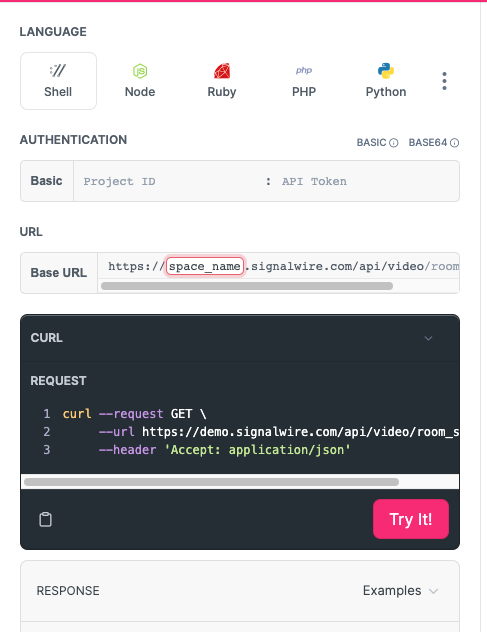Deleting Campaign Numbers from CSV
Overview
This snippet will show how you can easily use our Delete Phone Number Assignments Endpoint to remove specific phone number assignments from a campaign. This frees up the numbers to be used in any other campaigns or for use cases other than 10DLC messaging. You only need a CSV with numbers to remove in order to get started!
We will use Python to accomplish this, but check out our handy Try It feature in our docs by replacing the variables here with your own and running it in the browser. You can then easily copy the generated code in cURL or your favorite language!

Full code example: How to Delete Numbers from Campaign Based on CSV
from requests.auth import HTTPBasicAuth
import requests
import csv
SpaceURL = '.signalwire.com'
projectID = ""
authToken = ""
campaignID = ""
host = f"https://{SpaceURL}"
results = []
with open("Numbers.csv", 'r', encoding='utf-8-sig') as csvfile:
reader = csv.reader(csvfile)
next(reader, None)
for row in reader:
if "+" not in row[0]:
results.append("+" + row[0])
else:
results.append(row[0])
url = f"https://{SpaceURL}/api/relay/rest/registry/beta/campaigns/{campaignID}/numbers?page_size=1000"
payload = {}
headers = {}
response = requests.request("GET", url, headers=headers, data=payload, auth=HTTPBasicAuth(projectID, authToken)).json()
campaignNumbers = response['data']
while "next" in response['links'].keys():
response = requests.get(host + response['links']['next'], auth=HTTPBasicAuth(projectID, authToken)).json()
campaignNumbers.extend(response['data'])
for number in campaignNumbers:
tn = number['phone_number']['number']
assignmentSID = number['id']
if tn in results:
try:
url = f"https://{SpaceURL}/api/relay/rest/registry/beta/numbers/{assignmentSID}"
payload = {}
headers = {}
response = requests.request("DELETE", url, headers=headers, data=payload,
auth=HTTPBasicAuth(projectID, authToken))
if response.ok:
print(f"{tn} successfully deleted")
else:
print(f"{response.status_code} {response.text}. {tn} not deleted.")
except Exception as e:
print(f"Error: {str(e)}")
Required Resources
The API requires that you authenticate yourself using your Project ID, API Token, and Space URL. If you do not know where to find these values, check out our guide here!
You will need a campaign SID of the campaign containing the numbers you want to remove. Your campaign SIDs can be found in your portal under Messaging Campaigns -> Campaigns or by listing campaigns using our endpoint.

You will also need a CSV containing numbers to delete in the first column. You can name the column headers anything you want but if the number is not in the first column, you will need to adjust the code.
Numbers
+1xxxyyyzzzz
+1aaabbbcccc
How to Run the Snippet
If you copy the code and save it to a file named deleteNumbers.py, for example, to run it you will need to run:
MacOS/Linux - python3 deleteNumbers.py
Windows - py deleteNumbers.py
Step by Step Code Walkthrough
The first step is always to import the required libraries and assign values to all of the variables we'll need to use later. In this case, we will need to define our authentication variables and campaign SID.
from requests.auth import HTTPBasicAuth
import requests
import csv
# assign auth variables to be used later
SpaceURL = '.signalwire.com'
projectID = ""
authToken = ""
campaignID = ""
host = f"https://{SpaceURL}"
results = []
Next, we will read in the CSV of numbers and change the format to E164 if necessary. We will store all of these numbers in the results array to be used later in the code. If you don't have a header row, you can comment out line 4 in which we skip the first row.
# read in CSV of numbers to delete
with open("Numbers.csv", 'r', encoding='utf-8-sig') as csvfile:
reader = csv.reader(csvfile)
next(reader, None)
for row in reader:
if "+" not in row[0]:
results.append("+" + row[0])
else:
results.append(row[0])
To remove number assignments, we need to use the assignment ID of the number rather than the number itself. In order to get this ID, we are going to use the List Campaign Numbers endpoint itself to get all the extra data about the numbers needed.
# List All Campaign Numbers
url = f"https://{SpaceURL}/api/relay/rest/registry/beta/campaigns/{campaignID}/numbers?page_size=1000"
payload = {}
headers = {}
response = requests.request("GET", url, headers=headers, data=payload, auth=HTTPBasicAuth(projectID, authToken)).json()
campaignNumbers = response['data']
while "next" in response['links'].keys():
response = requests.get(host + response['links']['next'], auth=HTTPBasicAuth(projectID, authToken)).json()
campaignNumbers.extend(response['data'])
Great! Now that we have a list of all of our numbers in the campaign, we will iterate through it and release numbers that are also in the results array. If the number is deleted, we will print the success to the console. If not, we will log the error to the console so we know why it failed (i.e. wasn't found on the campaign, wasn't the right format, etc).
# loop through numbers and call delete number function on each if tn in results
for number in campaignNumbers:
tn = number['phone_number']['number']
assignmentSID = number['id']
if tn in results:
try:
url = f"https://{SpaceURL}/api/relay/rest/registry/beta/numbers/{assignmentSID}"
payload = {}
headers = {}
response = requests.request("DELETE", url, headers=headers, data=payload,
auth=HTTPBasicAuth(projectID, authToken))
if response.ok:
print(f"{tn} successfully deleted")
else:
print(f"{response.status_code} {response.text}. {tn} not deleted.")
except Exception as e:
print(f"Error: {str(e)}")
Wrap up
Keeping your brands/campaigns clean and up to date is very important to stay in compliance with all of the latest 10DLC requirements that The Campaign Registry has dictated. This script will let you remove numbers from your campaign quickly so that you don't have to go through them all one by one.
Sign Up Here
If you would like to test this example out, you can create a SignalWire account and Space.
Please feel free to reach out to us on our Community Slack or create a Support ticket from your SignalWire Space if you need guidance!